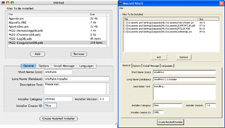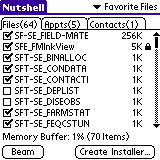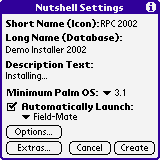I've installed enough PalmOS software onto my Treos and other Palms to know that sometimes it's easy, and sometimes it's a pain in the rear. If a program is complex and has lots of .prc (program) and .pdb (database) files, the developer often sells it wrapped up in a Windows self-extracting (".exe") installer you launch on your desktop, it tediously grinds away, and puts the PalmOS parts into the HotSync installer folder. Some developers put the pieces into a .Zip file you have to unpack and then figure out which parts get HotSynced, find your cable, hook it up, sync, and finally your new software is on your Treo.
Either of those methods of software installation is, frankly, irritating and cumbersome. Too many steps, takes too long, and you can't go to a Web site and easily download and install software sold in a .Zip file onto your Treo wirelessly, and you can't do it over the air at all, if all they give you is a Windows .exe installer.
 Nutshell doesn't create a Windows-based installer for end users. No .exe. No .Zip. This is the beauty of Nutshell. Installing Palm software with a Nutshell-built installer does not require a PC! This allows products to be distributed on other desktop platforms, as well as via over-the-air (OTA) delivery systems such as Treo software downloads.
Nutshell doesn't create a Windows-based installer for end users. No .exe. No .Zip. This is the beauty of Nutshell. Installing Palm software with a Nutshell-built installer does not require a PC! This allows products to be distributed on other desktop platforms, as well as via over-the-air (OTA) delivery systems such as Treo software downloads.
According to whatever industry analysts you choose to believe, Treos now account for 75 to 80 percent of Palm's total sales. The age of the unconnected PDA is quickly vanishing as smartphones' sales surge.
You've probably seen more and more programs include a "check for update" menu item or button. A couple years ago, this feature was rare. Now it's becoming the norm. This is a VERY good thing. The fewer hoops of fire you have to jump through to install new or updated software, the more likely you are to do it.
With over-the-air software updates, a developer or software vendor can push a new version of your freshly-purchased or already registered apps right into your Treo; it'll auto-install and over-write the old version, and you avoid that whole ugly download / unpack / hotsync dance.
Usability
Smarter developers who sell products that are totally Palm-based and have no desktop components use Nutshell to build their installers. But you don't have to be a developer to use it. Here's how it works:
 You feed Nutshell's elegantly simple interface your PalmOS .prc (program files) and .pdb (database files), a software license, if you want to include one, one, and an icon, tick off a few checkboxes, and smack the go button. Nutshell wraps everything up into a self-unpacking PalmOS installer file. Optionally, it'll create an uninstaller at the same time. It works so fast you might think nothing happened. Check the directory
You feed Nutshell's elegantly simple interface your PalmOS .prc (program files) and .pdb (database files), a software license, if you want to include one, one, and an icon, tick off a few checkboxes, and smack the go button. Nutshell wraps everything up into a self-unpacking PalmOS installer file. Optionally, it'll create an uninstaller at the same time. It works so fast you might think nothing happened. Check the directory
you told Nutshell to write its files to and there they are.
Get these two .prc files onto your Treo or other Palm, however you want to do it, HotSync, or over the air. Hey, you've got new app icons. Tap one and the installer installs your software and then politely deletes itself from your Treo.
If the developer has also included a Palm-side Nutshell uninstaller, that too appears on your Palm with its own icon. Tapping it will remove the program the self-erasing installer put there, and then the uninstaller will delete itself too. This is a totally slick and wonderful solution to what is normally a dreary routine.
With Nutshell there's no longer any need to distribute multiple .prc and .pdb files when distributing software, or to wrap them up in cumbersome Windows .exe Installers.
Nutshell has plenty of options for how you want to pack your PalmOS software and distribute it as a single, self-unpacking file. - make the file un-beamable
- auto-delete after installation
- auto-run the installer as soon as it's on the Treo
- use compression
- include an installation message
- include multiple installation languages
- create an uninstaller
And a whole lot more.
It's platform agnostic too... you can buy and download Nutshell as a Windows or Mac program, and they both INCLUDE a Palm version of Nutshell, so a self-installing .prc can be made on a desktop OR on a Treo or other Palm.
 The Windows version of Nutshell is a single program file, barely over 400k. Nutshell's documentation is fluent, easy for a novice to grasp, and comes as a bunch of inter-linked HTML files instead of a ponderous .pdf file.
The Windows version of Nutshell is a single program file, barely over 400k. Nutshell's documentation is fluent, easy for a novice to grasp, and comes as a bunch of inter-linked HTML files instead of a ponderous .pdf file.
I tried out Nutshell for Windows, by re-packing the .prc and .pdb files from another developer's software package I had previously downloaded and unpacked from his .Zip file. It worked brilliantly! I didn't even do a HotSync to get it onto my Treo. I just FTPd the Nutshell installer and uninstaller .prc files to a private area on my Web site, then grabbed them over the air with Blazer.
A minute to build the installer, mere seconds to put it on my site, a few seconds more to tell the phone to download it, and I had two new icons on my Treo's apps screen: one to install the program, another to uninstall it. Both worked flawlessly.
 Both the Windows and Mac versions come with the PalmOS version of Nutshell.
Both the Windows and Mac versions come with the PalmOS version of Nutshell.
Many developers, such as the highly-regarded Snapperfish (creators of SnapperMail) use Nutshell to pack and distribute their product as a single self-unpacking, self-deleting .prc installer. But you don't have to be a developer to think of numerous ways you could use it.
To be crystal clear, Nutshell is NOT a PalmOS program development system. It makes PalmOS program installers and uninstallers and that's ALL it does, but a child could use it.
Conclusion >>
Copyright 1999-2016 TreoCentral. All rights reserved :
Terms of Use : Privacy Policy
TREO and TreoCentral are trademarks or registered trademarks of palm, Inc. in the United States and other countries;
the TreoCentral mark and domain name are used under license from palm, Inc.
The views expressed on this website are solely those of the proprietor, or
contributors to the site, and do not necessarily reflect the views of palm, Inc.
Read Merciful by Casey Adolfsson
 Nutshell doesn't create a Windows-based installer for end users. No .exe. No .Zip. This is the beauty of Nutshell. Installing Palm software with a Nutshell-built installer does not require a PC! This allows products to be distributed on other desktop platforms, as well as via over-the-air (OTA) delivery systems such as Treo software downloads.
Nutshell doesn't create a Windows-based installer for end users. No .exe. No .Zip. This is the beauty of Nutshell. Installing Palm software with a Nutshell-built installer does not require a PC! This allows products to be distributed on other desktop platforms, as well as via over-the-air (OTA) delivery systems such as Treo software downloads.
 You feed Nutshell's elegantly simple interface your PalmOS .prc (program files) and .pdb (database files), a software license, if you want to include one, one, and an icon, tick off a few checkboxes, and smack the go button. Nutshell wraps everything up into a self-unpacking PalmOS installer file. Optionally, it'll create an uninstaller at the same time. It works so fast you might think nothing happened. Check the directory
You feed Nutshell's elegantly simple interface your PalmOS .prc (program files) and .pdb (database files), a software license, if you want to include one, one, and an icon, tick off a few checkboxes, and smack the go button. Nutshell wraps everything up into a self-unpacking PalmOS installer file. Optionally, it'll create an uninstaller at the same time. It works so fast you might think nothing happened. Check the directory
 The Windows version of Nutshell is a single program file, barely over 400k. Nutshell's documentation is fluent, easy for a novice to grasp, and comes as a bunch of inter-linked HTML files instead of a ponderous .pdf file.
The Windows version of Nutshell is a single program file, barely over 400k. Nutshell's documentation is fluent, easy for a novice to grasp, and comes as a bunch of inter-linked HTML files instead of a ponderous .pdf file.
 Both the Windows and Mac versions come with the PalmOS version of Nutshell.
Both the Windows and Mac versions come with the PalmOS version of Nutshell.